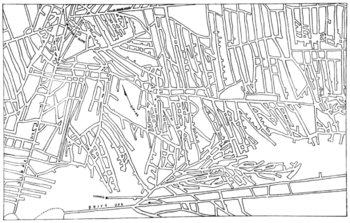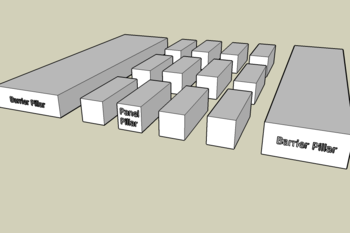
Room and pillar
Encyclopedia
Room and pillar is a mining
system in which the mined material is extracted across a horizontal plane while leaving "pillars" of untouched material to support the roof overburden
leaving open areas or "rooms" underground. It is usually used for relatively flat-lying deposits, such as those that follow a particular stratum
.
The room and pillar system is used in mining coal
, iron and base metal
s ores particularly when found as manto
or blanket deposits, stone
and aggregates
, talc
, soda ash and potash
.
The key to the successful room and pillar mining is selecting the optimum pillar size. If the pillars are too small the mine will collapse. If the pillars are too large then significant quantities of valuable material will be left behind reducing the profitability
of the mine
. The percentage of material mined varies depending on many factors, including the material mined, height of the pillar, and roof conditions; typical values are: stone and aggregates 75%, coal 60%, and potash 50%.
 Room and pillar mining is one of the oldest mining methods. Early room and pillar mines were developed more or less at random, with pillar sizes determined empirically and headings driven in whatever direction was convenient.
Room and pillar mining is one of the oldest mining methods. Early room and pillar mines were developed more or less at random, with pillar sizes determined empirically and headings driven in whatever direction was convenient.
Random mine layout makes ventilation planning difficult, and if the pillars are too small, there is the risk of pillar failure. In coal mines, pillar failures are known as squeezes because the roof squeezes down, crushing the pillars. Once one pillar fails, the weight on the adjacent pillars increases, and the result is a chain reaction of pillar failures. Once started, such chain reactions can be extremely difficult to stop, even if they spread slowly.
 Room and Pillar mines are developed on a grid basis except where geological features such as faults require the regular pattern to be modified. The size of the pillars is determined by calculation. The load-bearing capacity of the material above and below the material being mined and the capacity of the mined material itself will determine the pillar size.
Room and Pillar mines are developed on a grid basis except where geological features such as faults require the regular pattern to be modified. The size of the pillars is determined by calculation. The load-bearing capacity of the material above and below the material being mined and the capacity of the mined material itself will determine the pillar size.
If one pillar fails and surrounding pillars are unable to support the area previously supported by the failed pillar they may in turn fail. This could lead to the collapse of the whole mine. To prevent this the mine is divided up into areas or panels. Pillars known as barrier pillars separate the panels. The barrier pillars are significantly larger than the "panel" pillars and are sized to allow them to support a significant part of the panel and prevent progressive collapse of the mine in the event of failure of the panel pillars.
Mining
Mining is the extraction of valuable minerals or other geological materials from the earth, from an ore body, vein or seam. The term also includes the removal of soil. Materials recovered by mining include base metals, precious metals, iron, uranium, coal, diamonds, limestone, oil shale, rock...
system in which the mined material is extracted across a horizontal plane while leaving "pillars" of untouched material to support the roof overburden
Overburden
Overburden is the material that lies above an area of economic or scientific interest in mining and archaeology; most commonly the rock, soil, and ecosystem that lies above a coal seam or ore body. It is also known as 'waste' or 'spoil'...
leaving open areas or "rooms" underground. It is usually used for relatively flat-lying deposits, such as those that follow a particular stratum
Stratum
In geology and related fields, a stratum is a layer of sedimentary rock or soil with internally consistent characteristics that distinguish it from other layers...
.
The room and pillar system is used in mining coal
Coal
Coal is a combustible black or brownish-black sedimentary rock usually occurring in rock strata in layers or veins called coal beds or coal seams. The harder forms, such as anthracite coal, can be regarded as metamorphic rock because of later exposure to elevated temperature and pressure...
, iron and base metal
Base metal
In chemistry, the term base metal is used informally to refer to a metal that oxidizes or corrodes relatively easily, and reacts variably with diluted hydrochloric acid to form hydrogen. Examples include iron, nickel, lead and zinc...
s ores particularly when found as manto
Manto ore deposits
Manto orebodies are stratabound irregular to rod shaped ore occurrences usually horizontal or near horizontal in attitude.Manto deposits are an important source of copper, forming one of the world major copper resources in Chile and southern North America....
or blanket deposits, stone
Rock (geology)
In geology, rock or stone is a naturally occurring solid aggregate of minerals and/or mineraloids.The Earth's outer solid layer, the lithosphere, is made of rock. In general rocks are of three types, namely, igneous, sedimentary, and metamorphic...
and aggregates
Construction Aggregate
Construction aggregate, or simply "aggregate", is a broad category of coarse particulate material used in construction, including sand, gravel, crushed stone, slag, recycled concrete and geosynthetic aggregates. Aggregates are the most mined material in the world...
, talc
Talc
Talc is a mineral composed of hydrated magnesium silicate with the chemical formula H2Mg34 or Mg3Si4O102. In loose form, it is the widely-used substance known as talcum powder. It occurs as foliated to fibrous masses, its crystals being so rare as to be almost unknown...
, soda ash and potash
Potash
Potash is the common name for various mined and manufactured salts that contain potassium in water-soluble form. In some rare cases, potash can be formed with traces of organic materials such as plant remains, and this was the major historical source for it before the industrial era...
.
The key to the successful room and pillar mining is selecting the optimum pillar size. If the pillars are too small the mine will collapse. If the pillars are too large then significant quantities of valuable material will be left behind reducing the profitability
Profit (accounting)
In accounting, profit can be considered to be the difference between the purchase price and the costs of bringing to market whatever it is that is accounted as an enterprise in terms of the component costs of delivered goods and/or services and any operating or other expenses.-Definition:There are...
of the mine
Mining
Mining is the extraction of valuable minerals or other geological materials from the earth, from an ore body, vein or seam. The term also includes the removal of soil. Materials recovered by mining include base metals, precious metals, iron, uranium, coal, diamonds, limestone, oil shale, rock...
. The percentage of material mined varies depending on many factors, including the material mined, height of the pillar, and roof conditions; typical values are: stone and aggregates 75%, coal 60%, and potash 50%.
History

Random mine layout makes ventilation planning difficult, and if the pillars are too small, there is the risk of pillar failure. In coal mines, pillar failures are known as squeezes because the roof squeezes down, crushing the pillars. Once one pillar fails, the weight on the adjacent pillars increases, and the result is a chain reaction of pillar failures. Once started, such chain reactions can be extremely difficult to stop, even if they spread slowly.
Mine Layout

If one pillar fails and surrounding pillars are unable to support the area previously supported by the failed pillar they may in turn fail. This could lead to the collapse of the whole mine. To prevent this the mine is divided up into areas or panels. Pillars known as barrier pillars separate the panels. The barrier pillars are significantly larger than the "panel" pillars and are sized to allow them to support a significant part of the panel and prevent progressive collapse of the mine in the event of failure of the panel pillars.
See also
- Retreat miningRetreat miningRetreat mining is a term used to reference the final phase of an underground mining technique known as room and pillar mining. This involves excavating a room or chamber while leaving behind pillars of material for support. This excavation is carried out in a pattern advancing away from the...
- Longwall miningLongwall miningLongwall mining is a form of underground coal mining where a long wall of coal is mined in a single slice . The longwall panel is typically 3–4 km long and 250–400 m wide....

